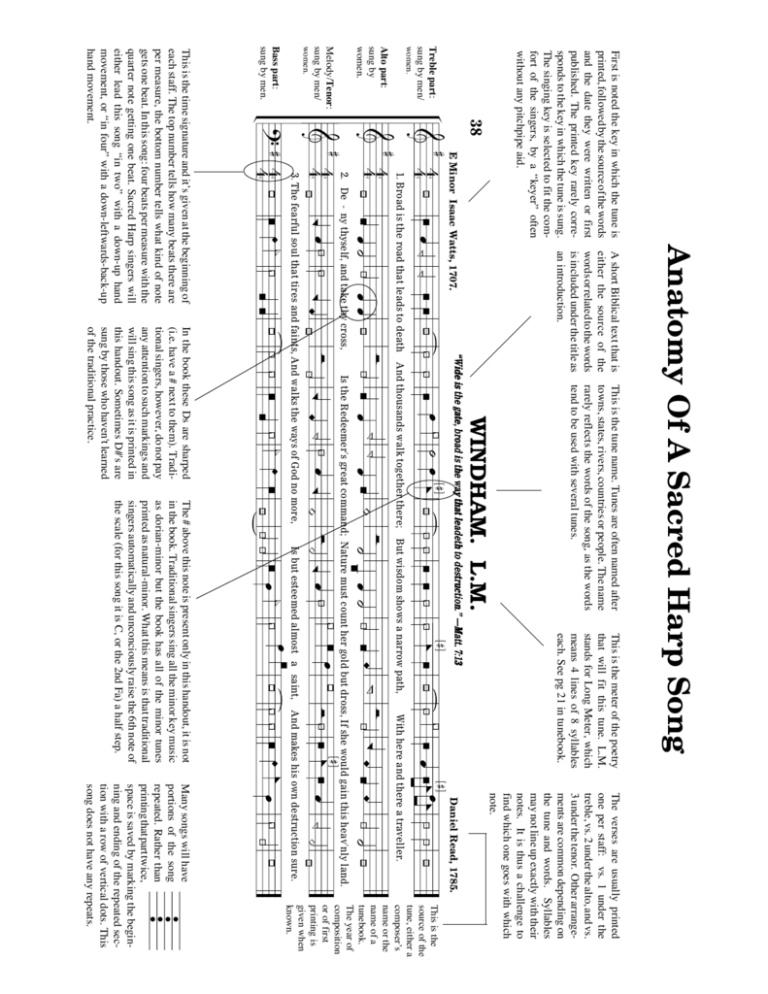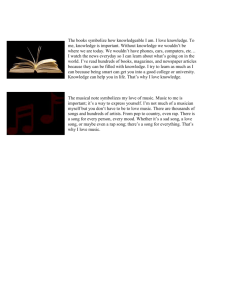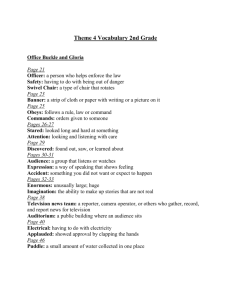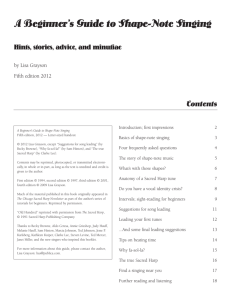Anatomy Of A Sacred Harp Song
advertisement

This is the tune name. Tunes are often named after towns, states, rivers, countries or people. The name rarely reflects the words of the song, as the words tend to be used with several tunes. This is the meter of the poetry that will fit this tune. L.M. stands for Long Meter, which means 4 lines of 8 syllables each. See pg 21 in tunebook. Anatomy Of A Sacred Harp Song A short Biblical text that is either the source of the words or related to the words is included under the title as an introduction. In the book these Ds are sharped (i.e. have a # next to them). Traditional singers, however, do not pay any attention to such markings and will sing this song as it is printed in this handout. Sometimes D#'s are sung by those who haven't learned of the traditional practice. The # above this note is present only in this handout, it is not in the book. Traditional singers sing all the minor key music as dorian-minor but the book has all of the minor tunes printed as natural-minor. What this means is that traditional singers automatically and unconciously raise the 6th note of the scale (for this song it is C, or the 2nd Fa) a half step. The verses are usually printed one per staff: vs. 1 under the treble, vs. 2 under the alto, and vs. 3 under the tenor. Other arrangements are common depending on the tune and words. Syllables may not line up exactly with their notes. It is thus a challenge to find which one goes with which note. This is the source of the tune, either a composer’s name or the name of a tunebook. The year of composition or of first printing is given when known. Many songs will have portions of the song repeated. Rather than printing that part twice, space is saved by marking the beginning and ending of the repeated section with a row of vertical dots. This song does not have any repeats. WINDHAM. L.M. 38 “Wide is the gate, broad is the way that leadeth to destruction.” —Matt. 7:13 Daniel Read, 1785. Isaac Watts, 1707. #E Minor Í ¿ ˙ Í [¡ v ¿ ¿ – – ¿ ¿ [¡ – v ¿ ¿ – Í –[¡ Í ¡ ¿ ¿ v 4 & 4 v – ͇ ‡ –– v ¿ ¿ – # 41. Broad is the road that leads to death And thousands walk together there; But wisdom shows a narrow path, With here and there a traveller. & 4 v – œ ˙ ¿ œ œ v Ó ¿ – œ ‡ ‡ œ – z Ó˙ œ ˙ ¿ – ‚ t Ó ¿ — ‚ – ‚ ¿ ˙ v – [ gain this heav'nly land. # 42. De - ny thyself, and take thy cross, Is the Redeemer's great command; Nature must count¿ her–goldœ butvdross, If she would ¡ ¿ – – Ó œ ‡ · v & 4 v — œ ¿ ¿ — ‚ v Ó ¿ — ‚ ‡ ¿ œ — z Ó· — œ ¿ Is but esteemed almost a saint, And makes his own destruction sure. 3. The fearful soul that tires and faints, And walks the ways of God no more, œ – Ò ‚ – Ò ¡ ‚ ‹# 4 v – ‚Ò ¿ ¿ ¿ – v œ ¿ ¿ v 4 –– v ¿ ¿ – – ¿ v ¿¿ – œ ¿ First is noted the key in which the tune is printed, followed by the source of the words and the date they were written or first published. The printed key rarely corresponds to the key in which the tune is sung. The singing key is selected to fit the comfort of the singers, by a “keyer” often without any pitchpipe aid. women. Treble part: sung by men/ Alto part: sung by women. Melody/Tenor: sung by men/ women. Bass part: sung by men. This is the time signature and it’s given at the beginning of each staff. The top number tells how many beats there are per measure, the bottom number tells what kind of note gets one beat. In this song: four beats per measure with the quarter note getting one beat. Sacred Harp singers will either lead this song “in two” with a down-up hand movement, or “in four” with a down-leftwards-back-up hand movement.







